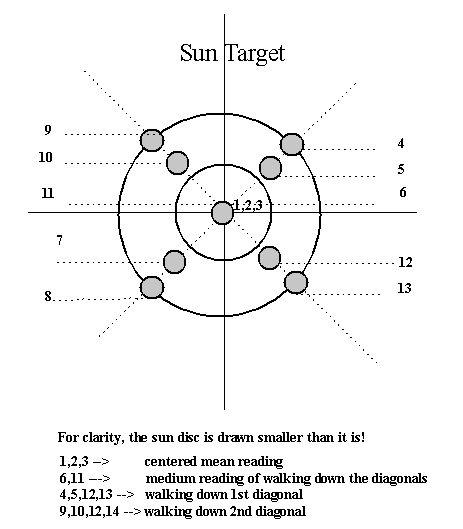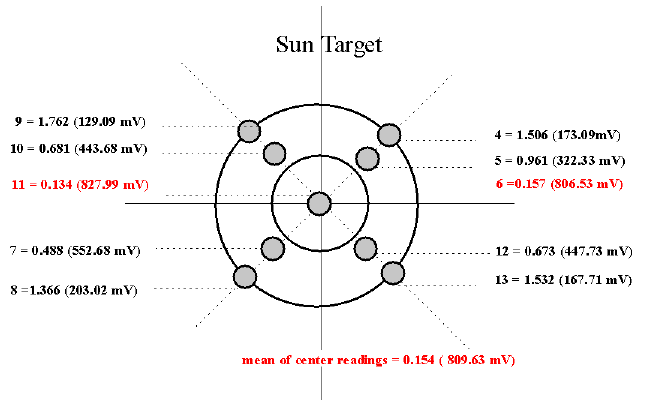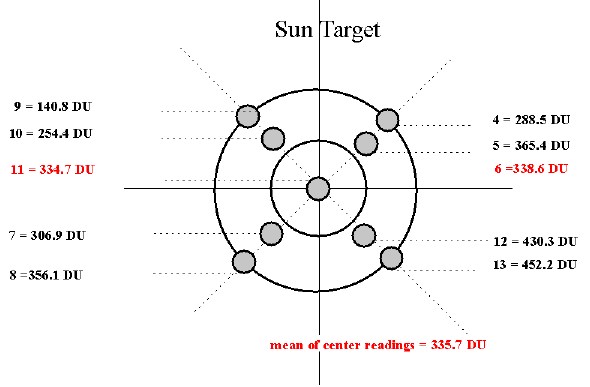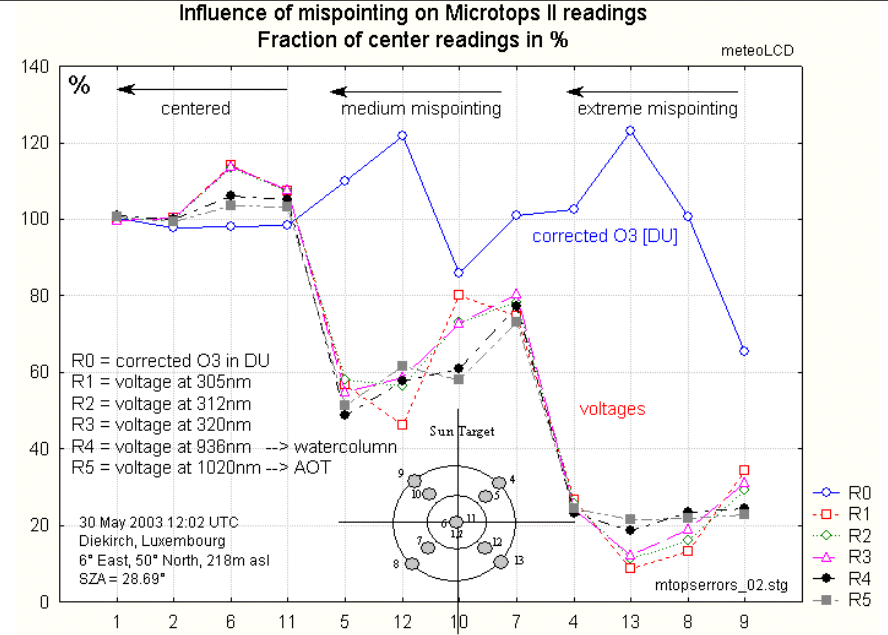version 1.1b
30 May 2003/06May2004/05Jan2005
| mtopserrors01.html
version 1.1b 30 May 2003/06May2004/05Jan2005 |
PDF version |
Francis
Massen
http://meteo.lcd.lu
| Abstract: | The Microtops II (serial 5375) readings are very sensitive to errors in pointing the sun disc to the sun target window of the instrument. This report shows the magnitude of the errors on the AOT and total O3 column readings resulting from deliberate mis-pointings. Errors in pointing always yield excessive AOT’s; the total O3 readings may be too low or too high. The raw voltages of all 5 channels follow a similar down-trend with increasing pointing error. |
| 1. | Procedure used |
13 measurements are made in a row: the first 3 by using a perfect
pointing, with the sun-disc exactly centered (instrument stabilized by laying
hands on support). The next 5 measurements are done with the sun disc occupying
the positions 4 to 8 of the figure on the first diagonal; the
next 5 measurements are made similarly on the 2nd diagonal

| 2. | Measuring conditions and results |
The Microtops II has been used at meteoLCD since 1997 [ref. 1]; a new sensor (serial 5375) based on the 5 wavelengths 305, 312, 320 (O3), 936 (for water column) and 1020nm (AOT) is in use since 1st May 2003. The measurements used for this report were made the 29th May 2003, under a cloudy sky with blue sky patches, at 12:01 UTC at the meteoLCD location (ca. 6° East, 50°North, 218m asl) . Each measurement took about 10 seconds, so the 13 measurements extend to approx. 2 minutes. This interval is short enough to assume a constant SZA.
2.1. Results for the AOT measured at 1020nm
| Conclusion: | The AOT readings deviate extremely, such as to give unusable values if the sun disk is not correctly centered on the target. The voltages decrease with increasing pointing error for both diagonals; even if this decrease is not exactly the same on both sides of the North-South line of the target window, the errors are staggering: more than 300% and 800% ! |
2.2. Total
Ozone Column readings O3(corr)

The solar zenith angle (SZA) is 28.4°
| Conclusion: | The deviations from the centered readings are impressive, but do not follow the simple trend found for the AOT: the TOC readings do not diminish with increasing pointing error, but fluctuate without any obvious pattern about the correct values. The greatest error is about 58%, again high enough to reject mispointed readings. |
| 3. | Variation
of the raw voltage |
The raw readings for every spectral channel are voltages; we will use the measurements from the 30th May 2003 at 12:02 UTC (SZA = 28.69°, same sky conditions as above) to illustrate the influence of bad pointing on these voltages.
The following graph gives the fraction of the measured voltages, and the computed corrected O3 column, relative to the 2 centered no mispointed measurements. It is obvious that all raw voltages follow the same trend: the voltages drop with increasing pointing error. The AOT and watercolumn are most influenced by this, being computed from a single voltage. This is not the case for the corrected O3 readings. Here the errors, even if high, are much less than those of the raw voltages.

Ichoku [ref. 3] writes that the AOT error
increases in exponential fashion with the deviation of the sun's image from the
center; our data of the raw voltages ( curve R5) confirm this: if we take the
three readings labeled 1, 12 and 13, the distances (x) from the center are about
0, 2 and 3 with the corresponding percental errors (E) 0, 20 and 80.
A best fit
(goodness of fit = 1) is the exponential E = 1.5*(exp(1.33*x) -1 ). It should be
noted that [3] corresponds to an AOT measured from the 936nm wavelength; here
AOT is based on the extinction of lambda = 1020nm.
| 4. | Overall conclusion |
The Microtops II demands good operating practice, and a steadied hand or a tripod mounting; its use on unsteady structures like ships ( see [ref. 2]) seems hazardous without any changes in the firmware algorithm.
References:
[1] http://meteo.lcd.lu/papers/ozone/uccle/uccle_01.html
[2] K. Knobelspiesse et al: Sun-Pointing-Error Correction for Sea Deployment of the Microtops II Handheld Sun Photometer. J. Atmos. Ocean Technol., Notes and Correspondence, May 2003, p. 767-771
[3] Ichoku Charles et al: Analysis of the performance characteristics of the five-channel Microtops II photometer for measuring Aerosol Optical Thickness and Precipitable Water Vapor. Journal of Geophysical research, Vol. 107, no. D13, 4179, doi:10.1029/2001JD001302, 2002. PDF version here.
Thanks to Dr. Christian Gueymard of Solar Consulting Services (chris@solarconsultingservices.com) and Jean Olivieri (jean.olivieri@meteo.fr) for numerous helps and suggestions; thanks to Kirk Knobelspieesse (mailto:kirk@simbios.gsfc.nasa.gov) for personal communications.
transferred to html and typos corrected: 31
May 2003
version 1.1a : title change (added "intentionally")
version 1.1b: added ref. [3] and exponential fit to AOT errors.